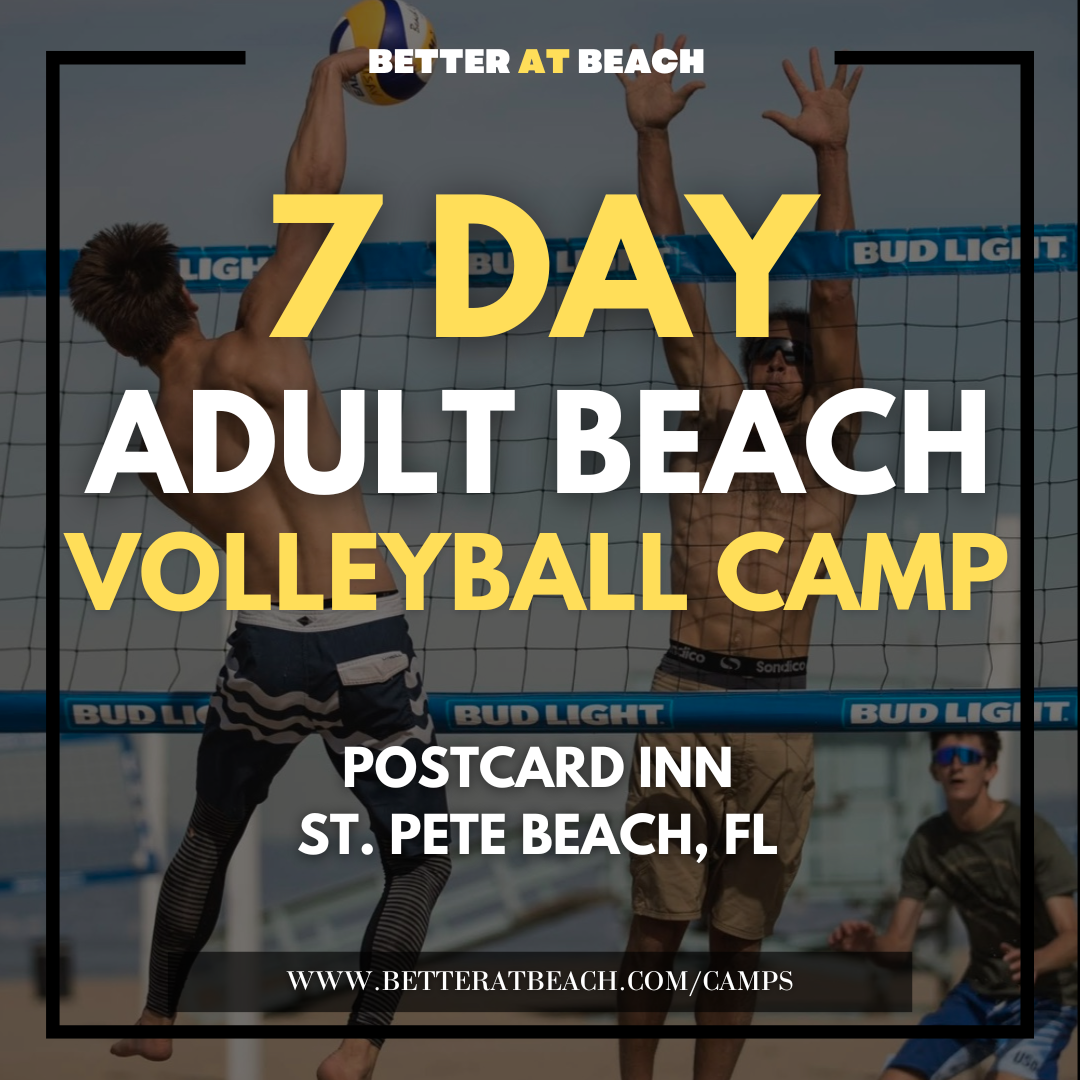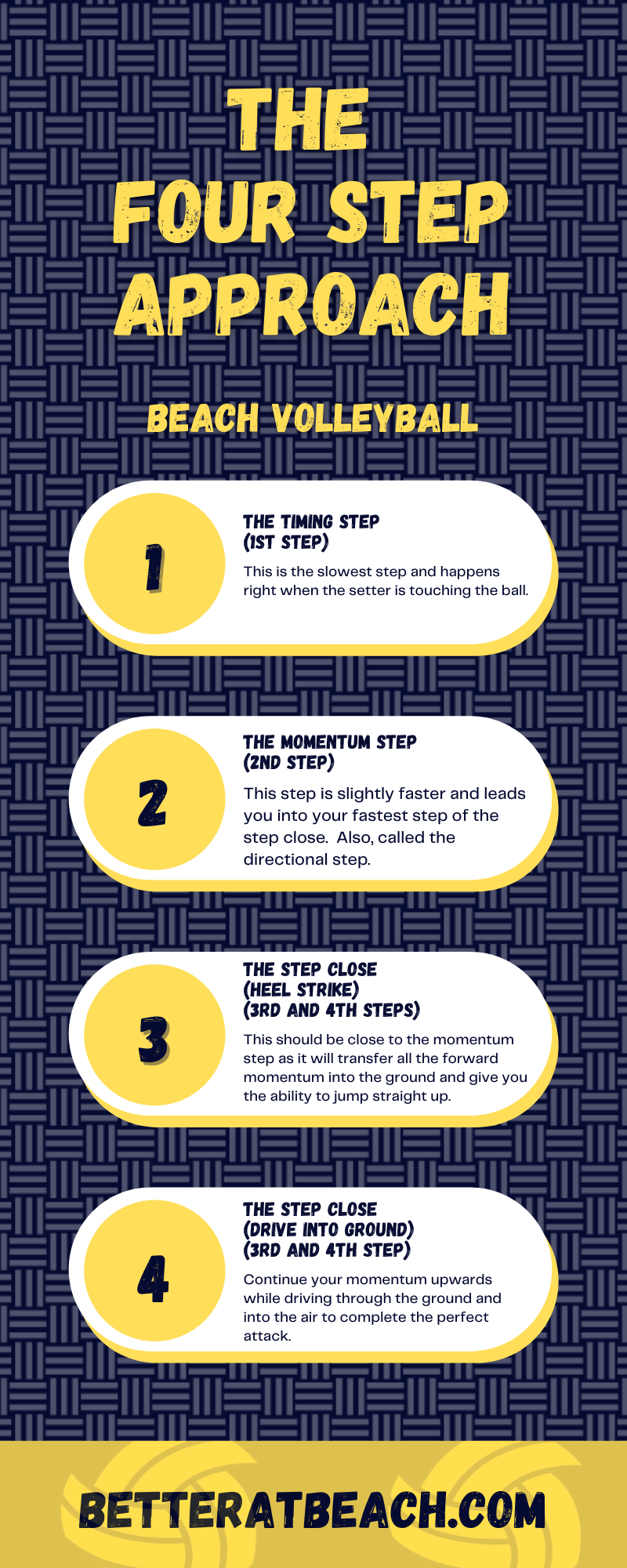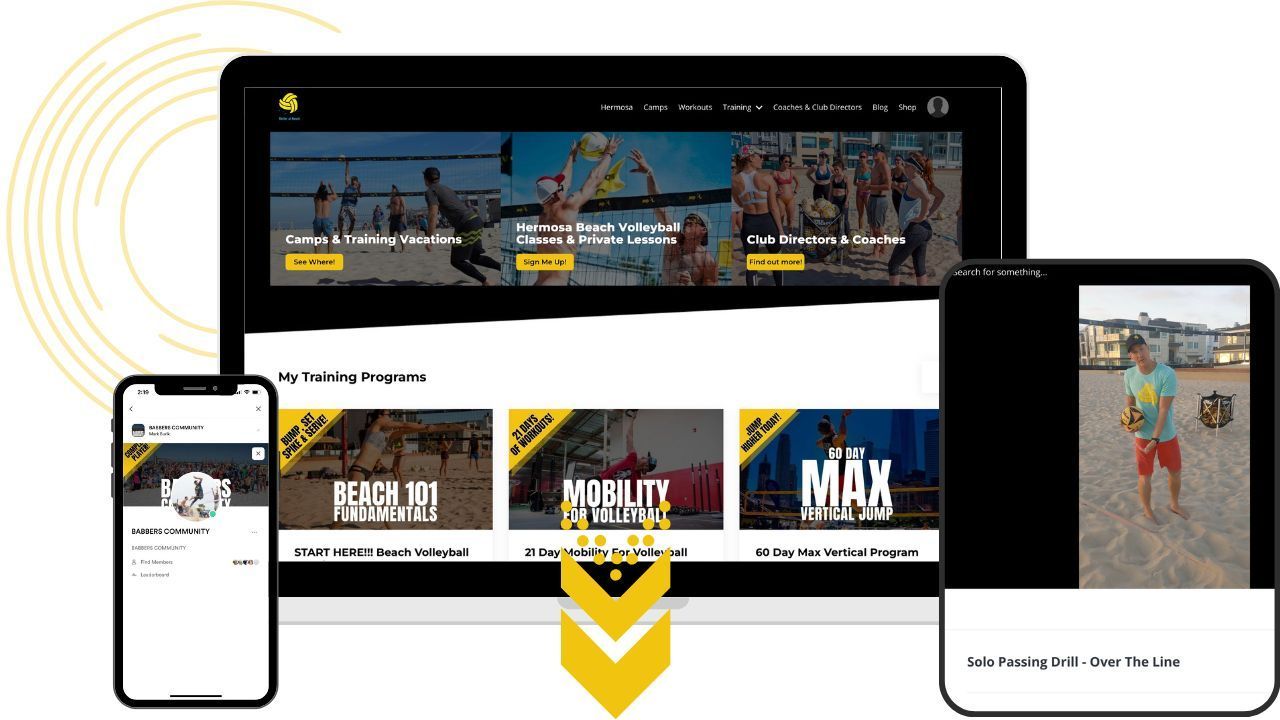
12 Beach Volleyball Spiking Tips and Drills: How to Attack with Vision
VISION MATTERS
“I got shots. I got every shot. I got shots for DAYSSS!” Cutty, high line, jumbo, short waterfall, waterfall over the block, chop cross, slime line, pit sizzling seam, deep middle… You name it I got it.”
So you can hit every spot on the court but you’re still getting dug like a pre-school sandbox. Why? Because you just aren’t using them at the right times. Why again? Because you're not LOOKING at the defense before you spike a volleyball!
You’ve spent hours working on your standing cut shot (which has next to zero translation to the real game) and it falls for a kill… sometimes. When it does hit the sand, you feel great.
But, there’s always that one defender that eats you up.
You dice. You hit hard. You shoot high line and you go away from your favorite swing all because you have to get one of your attacks to hit the ground. You have to try something to get the ball down!
You’ve tried every location and every type of swing and you’re still not hitting that 60% attack percentage that can win tournaments. It’s not your arm. It’s not your vertical. It’s not your setter.
IT'S YOUR VISION.
Do you want to elevate your game to the next level?
Spike a volleyball like a PRO and win more tournaments?
The ATTACKING COURSE is guaranteed to help players hit the next level.
We go WAY beyond the traditional "Learn how to spike a beach volleyball".
You will attack at a higher level AND raise your hitting percentage!
If you can't see what the defense is doing, where they are positioned and how they are moving, your attacking game will hit a very low ceiling and you won't get passed that until you learn how to spike with VISION!
If you’ve gotten to this point in a beach volleyball article, you probably have an idea what a spike approach in beach volleyball looks like but we need to go over it anyway. The approach can always get better and in our adult volleyball camps, mini volleyball trips and extended volleyball vacations, we break it down to make sure all of the inefficiencies are booted.
Beach Volleyball Spiking Tip #1: Use a four step approach
If you don't know what a four step approach looks like on the beach, check out this post or just come to one of our volleyball camps in St Pete, Florida. Our coaches will provide tons of spiking tips to help you jump higher and hit harder with vision.
If you want, you can use a three step approach or a four step approach but I will tell you that more than 99% of the players on the FIVB Beach Volleyball World Tour are using a four step approach. Check out some beach volleyball YouTube videos and start pausing the videos and playing them after the peak of the first contact. If you really want to learn how to spike in beach volleyball, be a student of the game and watch the attackers' steps and the footwork for the spike approach. Try to take your eyes off of the volleyball while watching film.
The majority of players start with their small first step just after the setter contacts the ball. Some players put their right foot down directly on set contact. From there, the best beach volleyball athletes in the world know how accelerate and increase the size of each remaining step. For right handers these steps are normally Right…Left..RIGHT-LEFT. It would be reversed for lefties and yes there are notable exceptions to this rule, who happen to be great attackers, like Phil Dalhausser and Aleksandrs Samoilovs but for simplicity’s sake we are sticking with the traditional approach.
Want to show your support and help us make more content?
Check out some of our favorites...
 |
|
|---|---|
| Upward Fitness |
The hands and arms should come back as the player is leaving their second step and swing up into a bow and arrow shape after the last two. The players in our intermediate and advanced volleyball classes are STILL working on these fine details every weekend. I, myself spent a good deal of last year making sure that I was getting my feet to the ball before I jumped.
So you’ve got all this down. You’re doing it consistently and making great contact with the ball but still not getting kills and terminating points. So what's the problem?
Beach Volleyball Spiking Tip #2: You have to hate the feeling of hitting without seeing!
You spent your entire approach watching the ball and now that you're in the air, loaded and ready to spike, you have no idea where to hit it because you still haven't seen the defense. This probably isn’t even running through your mind. At this stage, maybe your game isn’t developed enough to realize that you should be asking this question on every single attack: "How do I spike where they aren't?" We need to insert this thought process.
This question needs to be the basis for your entire offense in beach volleyball. If you want to hit the next level, you have to know how to attack with vision!
There are those players who think they are seeing the other side of the court but a lot of times they are looking at the wrong time. I see a lot of advanced players look at the other side of the court when their approach starts (when the setter is setting) but they never look again after that. This type of look gives the defense three steps worth of time to change their positioning without the attacker knowing. We have to look as late as possible while still being able to make good crisp contact on the ball.
If, for some reason, you had to hit a target using a bow and arrow while on a galloping horse, would you look at the target, then close your eyes for a second and a half, and THEN shoot the arrow? NOOOO!!! So why do hitter's look at the defense on the other side of the net after their pass and then never again?
Beach Volleyball Spiking Tip #3: You don't NEED to look at the defense after you pass... but you can.
Some players look at the court right after their pass and there CAN be benefit to this. It can re-orient you after a scramble play or a serve that puts you out of position. However, as a coach, I don’t usually focus on this during my lessons and practices because when you look before you start your spike approach, it is way too early. You won't get much valuable information from the defense. Good defenders make late moves when they know you can't see them. If you look before you even start your approach, that defender is not yet standing where they will end up. It's essentially false information.
I'm not saying it's wrong to look after your pass and before your spike approach, because for some players it trains their mind to stay focused on the defense. It cues their sense of sight. Go for it if it helps you see better but, again, this cannot be the last time you look!
Beach Volleyball Spiking Tip #4: Keep the ball, your setter, and the defense in front of you.
It should go without saying for my advanced players out there that you should pass forward. You ALWAYS want your partner to set from the front ten feet of the court close to the volleyball net. When you're learning how to spike and how to attack effectively, I encourage you to set more "up and down" balls so you can keep the other team your visual field.
If you come in too fast or the wind blows the ball so that you have to hit a ball from way behind you, it probably won’t be worth taking a look. This is a bad situation because you will have to track the ball flight just to get a solid contact. In this case, find a perimeter or the deep middle and hit there flat and fast. Don't guess with loopy shots after you've blinded yourself.
Beach Volleyball Spiking Tip #5: Get your feet to the ball first.
Moving on... For the purposes of this article we will use a four step approach. On our first step, our eyes should focus on the setter's contact so we can have great, accurate steps to the ball. Get a read on what type of contact your setter is likely to have so you can get your feet to the ball in the end.
Spiking Tips: On the left or second step our eyes are mainly focused following the ball but try not to look up. Your focus should be forward while tracking the volleyball and the other team.
On the second step (left foot for righties) you MUST follow the ball. This is crucial to getting yourself in a great hitting position. In beach volleyball it’s massively valuable to get your last two steps to be right behind the ball so you can jump a little bit straighter than in indoor volleyball.
Our left foot (right foot for lefties) is our power and direction foot. It’s the left foot’s job to take us to the spot we will jump from. If you aren't focusing on the ball during your left step; if you look too early or too long at the defense; you won’t be able to get your feet to the right position for attacking. We go over this in depth in our beach volleyball attacking course which is packed with spiking tips for beach volleyball players. Better yet, you can always come to one of our adult volleyball camps which have over 35 hours of training, lessons from pro's, theory sessions and tournaments.
Beach Volleyball Spiking Tip #6: Look on the last two steps of your approach, when your arms go back.
Now that the left foot is in the process of getting your feet to the best spot, you will have to take a late quick look. Your eyes will leave the ball (try to keep it in your peripheral) and focus forward for an instant as your third step is hitting the ground just before you jump and spike.
You only have a flash of time to see where the defense is. You have to find the ball again quickly so whatever you see in that flash, trust yourself and go for it. Don't keep looking until the defender shows their cards or you'll lose track of the ball and you'll lose height on your spike.
Beach Volleyball Spiking Tip #7: Know your strengths. Big hitters should see blockers. Shooters need to track defenders.
Not every player uses these spiking tips for eye sequence. There are players like Alison Cerutti who prefer to just beat the block peripherally and hit with power. Players like these can swing hard enough from a variety of positions to overpower most defenders but they still have to keep their mental and visual focus in front of them to score points. Some players have a great sense of game flow and superb peripheral vision so they might not use the hard 'look' at the end of their approach. For those of us who are mere mortals and forced to use more tools to win in beach volleyball, we have to use our eyes.
Beach Volleyball Spiking Tip #8: Keep Your Jaw Down!
If you're spiking and you look at the defense too early, you will lose track of the ball AND have a false sense of where the defenders are. If you jump from too far under the ball, you will have to look UP instead of forward and you will lose your peripheral view of the court. Try to keep your head level and your jaw down throughout your approach and swing. Don't let the front of your neck fully stretch and you'll be in a better spot to use your eyes.
Beach Volleyball Spiking Tip #9: Don't Hang!
If you hang before you hit (my personal issue) you will lose height and crispness on your spike contact so the defenders will be able to catch up. Hit on your way up or at the top of your jump but take the soft, loopy shots out of your arsenal.
Beach Volleyball Spiking Tip #10: If you want to make sure you're doing it right, film it from the side.
Set up a camera or a smartphone on the side of your court next time you play. Check out what your eyes are doing during water breaks or after practice. Get comfortable using the proper sequence. Force yourself to do it! The look can be as valuable as the jump itself in terms of kill percentage. If you’re still unsure, send us some video and let us show you what’s happening in your game. We have a great team that can dissect your game and give you great feedback right to your inbox.
Beach Volleyball Spiking Tip #11: When watching professional beach volleyball players, look at their eyes instead of the ball.
Alexander Huber demonstrates all of these spiking tips in the beach volleyball lesson below.
Beach Volleyball Spiking Tip #12: Practice using your vision with these spiking drills from Better at Beach.
Attack Vision – Short Over The Block
Sometimes in beach volleyball, we can feel open spots by feeling the blocker. So, normally if a blocker is blocking line, it means the defender is sitting in the cross. So, we're going to come out of the middle as an attacker, and we're going to use the blocker as our signifier for where we should go. Once they get the set into the middle of the court, I'm going to shift as the blocker to show them that they should go over me and get it to the sidelines.
The key is, I've drawn boxes on the sidelines about 10 feet off of the net because you need to get this ball far enough from the blocker so that they can't drop and pursue it. If you leave it right behind them, they can collapse from their jump, pursue the ball behind them, pick it up. If you get it far enough behind the blocker and far enough in front of the defender it makes it a really difficult ball to get. Most defenders anticipate high lines to deep corners so even if they read you going over the blocker, you might beat them if they take the deeper pursuit angle.
3-Person Vision Pepper
This is a three-man pepper with the middle person acting as a full time setter. After the set the person who is about to play defense is either going to leave their hands in a natural defensive position which is hands down, palms up or they can put their hands in front of their face. The hitter’s job is to get their feet to the set, then find the high or low sign and finally deliver a high or low spike. Watch it on the video!
Dig, Set, Look, Hit!
This drill is a great "Coach on One" drill. It's included in our 50+ Beach Volleyball Practice Plans for Coaches and Advanced Players but it works exactly the same if you only have two players. We have a specific serving target that one player needs to hit. If he or she hits that target then they're going to enter the court and play defense.
At our camps and classes in Redondo Beach and Manhattan Beach, we encourage our players to go through their entire defensive rhythm. That means that they enter the court shaded middle which is right in between dead middle and diagonal from the hitter. The coach or drill facilitator will clap which we have to imagine is the set. After the set (clap) the defender can release to their final position. Finally, the coach or facilitator can throw the ball wherever they want.
The defender needs to dig that ball and then we get to use all of our best spiking tips.
They need to pass to themselves, set to themselves and look for the coach who's going point at a target. The player has to spike hard or shoot to the target to get a point. Of course you can do this with more than one player on that side and if you have enough people, you definitely should keep the drill as game-like as possible. I just wanted to show you it's possible to do great drills when you only have two people. One of them doesn't even need to be a volleyball player!
Watch the video to see it in action and click on the bottom right of the video screen to subscribe to our channel. It helps us in a big way so we can keep creating beach volleyball video lessons and online courses.
Spice Up Your Beach Volleyball Warm-Up: Two-Touch Pepper
In this video, we show you how to spice up your warm-up with a two-touch pepper that includes digging and spiking with vision. Put all of our tips for spiking to good use!
Self-Toss Target Practice
This is a great warm-up drill for spiking with vision. When you're starting to get your arm loose, it's really important to be able to control the ball with vision. Toss to yourself and make sure that you toss well above the top of the antenna. After you follow where the ball is, then your eyes need to drop and focus on your partner.
After the peak of the ball, your partner is going to put one hand anywhere they want. Your job is to reach to the top of your swing and try to snap the ball to their hand on that line. All they need to do is catch the ball and then it's their turn. Toss above the top of the antenna, find the ball, get to the ball, find the target, find the ball again, and snap to that hand target.
Solo Beach Volleyball Drill: Roof Pepper with Vision
We’ve been getting a lot of requests for lonely or solo volleyball drills so I’m going to show you spiking drills that incorporate vision. I used to do it at my summer house all the time. I pass to myself. I set to myself. Then, I hit the ball on the roof. But I’m going to include something that has vision work.
After you pass to yourself and set to yourself, between your set and your soft spike, you have to look forward at the wall and then back to the ball to hit. I’ll make an exaggeration: Just watch my eyes, watch my head tilt, and you can get some vision work while you’re doing this.
If you’re trying to get a little fitness in, it would be a sweet idea if you can add a little burpee in between the roll, so if you’ve got an angled roof, give it a shot: burpee between every roll. A little pepper, a little vision work, and some burpees.
I hope you enjoyed all of my best spiking tips for beach volleyball players.
Happy Spiking :)








